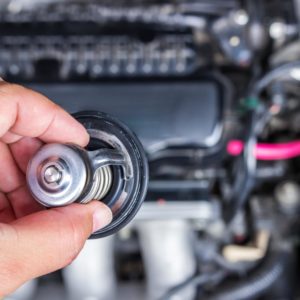Diesel engines use the selective catalytic reduction method to reduce NOx emissions. This method is done by injecting diesel exhaust fluid (DEF) into the exhaust stream, triggering a chemical reaction that breaks down NOx into nitrogen and hydrogen. The DEF is stored in a tank where it’s kept warm by a reductant heater. If the powertrain control module notices that the DEF heater isn’t operating as it should, on-board diagnostics will log a P20BD code.
What Does the P20BD Code Mean?
Diagnostic trouble code (DTC) P20BD stands for “Reductant Heater ‘B’ Control Circuit/Open.”

DEF is a colorless, odorless, and non-toxic nitrogen fertilizer that’s injected into the catalyst, converting leftover exhaust particles into harmless gases.
The DEF is kept inside a tank or reductant injector supply hose where a heater keeps it warm to prevent the fluid from freezing or crystallizing under extremely cold temperatures.
Note: The definition of code P20BD might be different depending on the vehicle manufacturer. Consult the appropriate repair manual or repair database for the exact code definition.
What are the Common Causes of the P20BD Code?
- Reductant tank heater failure
- Wiring issues
- Glow plug control module failure
- Defective reductant temperature sensor
- PCM programming error

What are the Common Symptoms of the P20BD Code?
- Illuminated check engine light
- Diesel particulate filter (DPF) regeneration might not occur
- Poor fuel economy
- Diminished engine performance
How to Diagnose the P20BD Code
Vehicles equipped with an OBD-II system can register a P20BD code. However, keep in mind that the diagnostic process for this code can vary depending on vehicle specifications. Factors like the vehicle’s year, make, and model can alter the steps for diagnosing the P20BD code.
Diagnosing a DTC P20BD might require you to use a scan tool and check the affected system for any sign of damage. If you’re not familiar with how the process works, you can always take your vehicle to a repair shop and have trained professionals do the job for you. But if you think you’ll be fine on your own, then you can go ahead and proceed with the diagnostic process.
Here’s a short video you might want to check out to get an idea of what the process might involve.
How to Fix the P20BD Code
Attempting to fix a P20BD code can be frustrating and confusing without the right tools and technical information. If done incorrectly, your vehicle could even develop more problems. Under these circumstances, it’s best to have a certified mechanic do the job for you to ensure that all steps and protocols are followed correctly.
But if you’ve had your fair share of resolving DTCs before, then you’re well aware that there’s no magic bullet that will fix all codes for all makes and models. So before you begin, make sure to gather vehicle-specific repair information from guides like Chilton or an ALLDATA subscription.
Any information provided on this Website is for informational purposes only and is not intended to replace consultation with a professional mechanic. The accuracy and timeliness of the information may change from the time of publication.




















